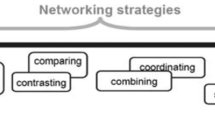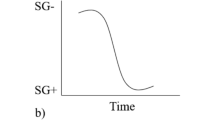Abstract
This research draws on Legitimation Code Theory (LCT) to understand the epistemic dimension of the higher education classroom discourse of a professor who is well evaluated by his students. In expository science classroom discourse, concepts are loaded with different meanings, a process that is called “condensation of meanings” in LCT, and are expressed using the concept of epistemic semantic density (ESD). The ESD can vary in classroom discourse, generating what is called a semantic wave in the LCT context. In this work, we initially compare two different translation devices, which are ways of systematically exploring the characteristics of the knowledge expressed in the classroom and how they vary, generating semantic waves. We were able to observe the strengths and weaknesses of both devices. They proved to be powerful tools in revealing how the complexity of science knowledge varies in a lesson. However, neither one demonstrates how meanings are connected in the lesson or how the semantic density of a particular concept changes over time. In this sense, we explore how everyday words at times become loaded with technical meaning when other concepts are connected to them. To achieve that, we use third device based on network science, an approach that analyzes and represents the systems of interactions of a wide range of physical and social phenomena. This allows us to evaluate how a term commonly used in everyday language, such as “lamp,” can play a central role in the construction of meanings related to the episteme of chemistry. In addition, while LCT assumes that semantic waves necessarily optimize learning, the results obtained herein revealed that constellation of meanings does not directly relate to semantic waves.





Similar content being viewed by others
Notes
Question 1: Would you recommend your colleagues to take this professor’s course? Question 2: Would you take a second course with this professor?
References
Ashwin, P., Boud, D., Calkins, S., Coate, K., Hallett, F., Light, G., Luckett, K., MacLaren, I., Mastensson, K., McArthur, J., McCune, V., McLean, M., & Tooher, M. (2020). Reflective teaching in higher education (2° ed.). New York: Bloomsbury academic.
Bastian, M., Heymann, S., & Jacomy, M. (2009). Gephi: an open source software for exploring and manipulating networks. International AAAI conference on weblogs and social media.
Blondel, V. D., Guillaume, J.-L., Lambiotte, R., & Lefebvre, E. (2008). Fast unfolding of communities in large networks. Journal of Statistical Mechanics: Theory and Experiment, 2008(10), P10008. https://doi.org/10.1088/1742-5468/2008/10/p10008.
Brandes, U. (2001). A faster algorithm for betweenness centrality. Journal of Mathematical Sociology, 25(2), 163–177.
Chin, C. (2007). Teacher questioning in science classrooms: approaches that stimulate productive thinking. Journal of Research in Science Teaching, 44(6), 815–843.
Erduran, S., Simon, S., & Osborne, J. (2004). TAPping into argumentation: Developments in the application of Toulmin’s argument pattern for studying science discourse. Science Education, 88(6), 915–933.
Espinosa, M. A. (2013). The individualization of learning and cooperative work through Information and Communication Technologies in Education (ICTE). História y Comunicacion Social, 18(Edicíon especial), pp 765–780.
Golafshani, N. (2003). Understanding reliability and validity in qualitative research. The Qualitative Report, 8(4), 597–607.
Hand, B. M., Alvermann, D. E., Gee, J., Guzzetti, B. J., Norris, S. P., Phillips, L. M., Prain, V., & Yore, L. D. (2003). Message from the “island group”: what is literacy in science literacy? Journal of Research in Science Teaching, 40(7), 607–615.
Jiménez, J. P. C., Melo, G., Bacigalupo, F., & Manghi, D. (2016). Waves of meaning in teacher-student interaction: analysis of two Natural Sciences classes in a 6th grade of primary school. Ciência & Educação, 22(2), 335–350.
Johnstone, A. H. (1982). Macro and micro-chemistry. School Science Review, 64(227), 377–379.
Lambiotte, R., Delvenne, J.-C., & Barahona, M. (2008). Laplacian dynamics and multiscale modular structure in networks. IEEE: Transactions on Network Science and Engineering, 1(2), 76–90.
Lemke, J. L. (1990). Talking science: language, learning, and values. Norwood: Ablex.
Lincoln, Y. S., & Guba, E. G. (1985). Naturalistic inquiry. Newbury Park: Sage.
Macnaught, L., Maton, K., Martin, J. R., & Matruglio, E. (2013). Jointly constructing semantic waves: implications for teacher training. Linguistics and Education, 24(1), 50–63.
Martin, J. R., Maton, K., & Doran, Y. J. (2019). Accessing academic discourse: systemic functional linguistics and legitimation code theory. New York: Routledge.
Maton, K. (2013). Making semantic waves: a key to cumulative knowledge-building. Linguistics and Education, 24(1), 8–22.
Maton, K. (2014). Building powerful knowledge: the significance of semantic waves. In B. Barrett & E. Rata (Eds.), Knowledge and the future of the curriculum (pp. 181–197). London: Palgrave Macmillan.
Maton, K. (2016). Legitimation code theory: building knowledge about knowledge-building. In K. Maton, S. Hood, & S. Shay (Eds.), Knowledge-building: educational studies in Legitimation Code Theory. New York: Routledge.
Maton, K., & Doran, Y. J. (2017). Semantic density: a translation device for revealing complexity of knowledge practices in discourse, part 1—wording. Onomázein, (Número especial LSF y TCL sobre educación y conocimiento), pp 46–76.
Matruglio, E., Maton, K., & Martin, J. R. (2013). Time travel: the role of temporality in enabling semantic waves in secondary school teaching. Linguistics and Education, 24(1), 38–49.
Mehan, H. (1979). Learning lessons. Cambridge: Harvard University Press.
Mortimer, E. F., & Quadros, A. L. (Eds.). (2018). Multimodalidade no Ensino Superior. Ijuí: UNIJUÍ.
Mortimer, E., & Scott, P. (2003). Meaning making in secondary science classrooms. Maidenhead: Open University Press.
Pozzer, L., & Roth, W.-M. (2019). A cultural-historical perspective on the multimodal development of concepts in science lectures. Cultural Studies of Science Education, 15(3), 1–40.
Quadros, A. L., & Mortimer, E. F. (2018). Aulas no Ensino Superior: estratégias que envolvem os estudantes. Curitiba: Appris.
Santos, B. F., & Mortimer, E. F. (2019). Ondas semânticas e a dimensão epistêmica do discurso na sala de aula de química. Investigações em Ensino de Ciências, 24(1), 62–80.
Scott, P. H., Mortimer, E. F., & Aguiar, O. G. (2006). The tension between authoritative and dialogic discourse: a fundamental characteristic of meaning making interactions in high school science lessons. Science Education, 90(4), 605–631.
Sinclair, J. M., & Coulthard, M. (1975). Towards an analysis of discourse: the English used by teachers and pupils. London: Oxford University Press.
Tiberghien, A. (1994). Modeling as a basis for analyzing teaching-learning situations. Learning and Instruction, 4(1), 71–87.
Tytler, R., & Aranda, G. (2015). Expert teachers’ discursive moves in science classroom interactive talk. International Journal of Science and Mathematics Education, 13(2), 425–446.
Yore, L. D., & Treagust, D. F. (2006). Current realities and future possibilities: Language and science literacy—empowering research and informing instruction. International Journal of Science Education, 28(2–3), 291–314.
Acknowledgments
We thank the kind support of Thomaz Lüscher Dias and Lúcio Rezende Queiroz. This research was supported by Coordenação de Aperfeiçoamento de Pessoal de Nível Superior (CAPES) and Conselho Nacional de Desenvolvimento Científico e Tecnológico (CNPq).
Author information
Authors and Affiliations
Corresponding author
Additional information
Publisher’s Note
Springer Nature remains neutral with regard to jurisdictional claims in published maps and institutional affiliations.
Rights and permissions
About this article
Cite this article
Barreto, L.P., Rodrigues, A.A.D., de Oliveira, G.C. et al. The Use of Different Translation Devices to Analyze Knowledge-Building in a University Chemistry Classroom. Res Sci Educ 51, 135–152 (2021). https://doi.org/10.1007/s11165-020-09969-z
Accepted:
Published:
Issue Date:
DOI: https://doi.org/10.1007/s11165-020-09969-z




